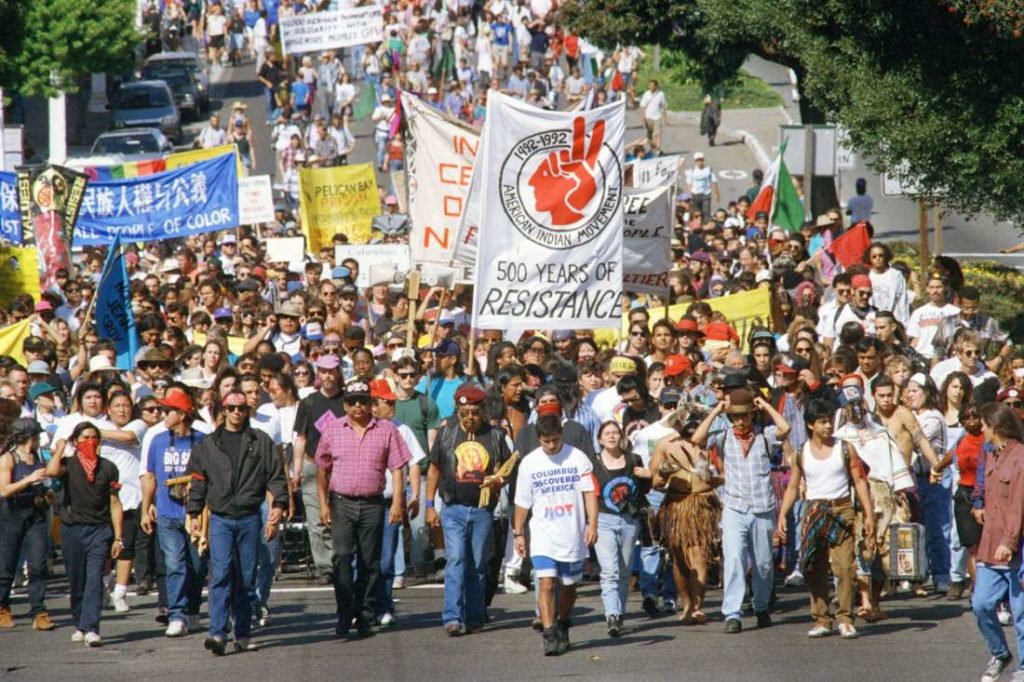Indigenous Peoples’ Day was first formed in 1992, when our very own city of Berkeley became the first city to celebrate and recognize the holiday, in protest to the 500th anniversary of Columbus’s arrival to the United States. As an Institute that is situated on the territory of xučyun (Huichin), the ancestral and unceded land of the Chocenyo speaking Ohlone people, we would like to take a moment to honor the Indigenous Peoples who have lived in this country for thousands of years, and celebrate their histories and cultures. Below you will find resources and courses for Spring 22 that focus on the artistic, technological, and design contributions of Indigenous Peoples, historically and as they continue today. Thank you to our partners and speakers for sharing their resources with us. You can learn more about the UC Berkeley land acknowledgement here.

The All Nation Singers chant in appreciation to the city of Berkeley, CA., during the first Indigenous Peoples Day, October. 10, 1992. Photo by Paul Sakuma, from SFGate.
COURSES
HUM 10 Compass Course, Indigenous Arts in the Americas: Old and New Media
This class investigates recent Indigenous creative practices—including poetry, film, dance, photography, and textiles—from across the Americas to think about how these forms of making and expression are not discrete but rather intimately woven together.
This course centers on the design, construction, sustainable use, and experimental variables in archaeological feature visibility of a broadly used food technology, earthen ovens. Known as the horno in the US Southwest, this colonial introduction is the focus of our seminar, experimenting with construction techniques and using them to cook a variety of indigenous and introduced foods. Collaboratively-built hornos will be touchstones for exploring how cultural and historical tradition intersects with contemporary practice via 3D clay fabrication techniques and through the creative lens of installation, land art, and social practice.
RESOURCES AND PROJECTS
Indigenous Technologies, Berkeley Center for New Media
Indigenous Technologies is a program of the Berkeley Center for New Media that engages questions of technology and new media in relation to global structures of indigeneity, settler colonialism and genocide in the 21st century. The program hosts public events and facilitates ongoing conversations with Indigenous scholars and communities to critically envision and reimagine what a more just technological future can look like. Learn more here.
The Native Graphic Design Project
The Native Graphic Design Project was founded by our recent Design Field Notes speaker, Neebinnaukzhik Southall, a graphic designer and a member of the Chippewas of Rama First Nation. The NGDP was started as a way to increase the visibility of Native, Native American, First Nations, American Indian, AmerIndian, Aboriginal, Metís, Native Alaskan, Indigenous, Indígina, and Inuit people working in the field of graphic design.
Check out Neebin’s compiled list of Native graphic designers, as well as their own work and practice, Neebin Studios.
Desert Sunrise Project
Coordinated through Patrick Naranjo, Director of UC Berkeley’s American Indian Graduate Program, and the Moapa Band of Paiutes and UNLV School of Architecture, the Desert Sunrise Project highlights the Indigenous people and cultures that have existed in the Las Vegas Valley since time immemorial. Learn more here!